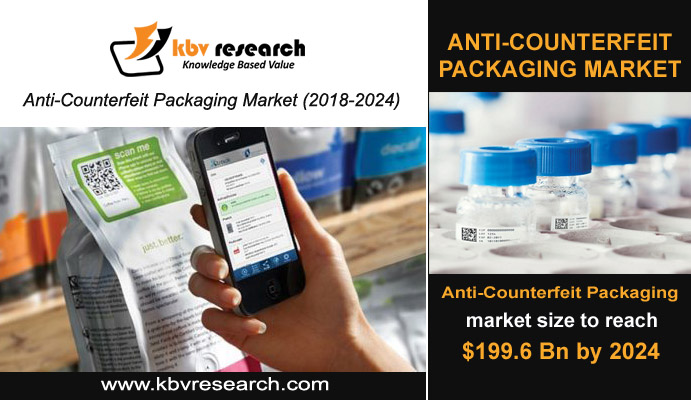
Safe packaging is one of the most important forgery avoidance techniques. Anti-counterfeit packaging provides a safe packaging for the product to eradicate alleged breaches and falsification. Anti-counterfeit packaging helps prevent imitation and allows products to be authentic and safe. A company is predominantly taking anti-counterfeit measures to help the company reduce losses due to the relevance and confidence of counterfeit revenues.
Counterfeits are unauthorized brand replicas identical to genuine products. Falsified goods include clothing, jewelry, medicines, cigarettes, electronic equipment, and parts, but are not limited to them. Safe packaging is needed to avoid counterfeit products. Anti-counterfeit packaging is perceived as the process by which the product is assigned to secure packaging to minimize forgery or infringement. Anti-counterfeit packaging is the safe process of packaging that prevents imitation and confirms the goods' safety.
Companies take measurements against counterfeiting to minimize losses due to falsification of income and loyalty. Cost is the major factor that leads to counterfeiting. It is noted, however, that drugs and food items costing less are mostly counterfeited because of lower risk of penalties. In both counter and prescription drugs, anti-counterfeit packaging is used. Increasing internet demand for counter-drugs increases counterfeiting incidence. The implementation of the RFID (radio frequency identification) technology can mitigate these threats.
One of the most evident aspects of corporate brand protection is an unwavering fight against counterfeiters. To ensure that brands and packaging / printing partners together protect packaging and labels against those who try to profit at their expense, a multi-layered protection plan is required. As a result of counterfeiting, food products, pharmaceuticals and other retail products suffer income losses and immaterial assets. Also, changing the method of brand retrieval can make it difficult to identify the original product and help counterfeiters to create more falsifications. Thus, in order to boost the packaging industry, manufacturers should increase their efforts to reduce losses from counterfeit products.
Falsification practices are more common in underdeveloped and developing nations as compared to the developed ones. However, the lack of awareness of customer-validated food and pharmaceutical products bother market expansion in many underdeveloped areas around the world. The global food and beverage industries, as well as pharmaceutical and retail products, suffer a loss due to intangible assets. Any fundamental or crucial changes in the process of brand retrieval can create a barrier to the recognition of the real product and can certainly assist the forgers on behalf of the first product in the production of fake products.
Click Here For Free Insights: https://www.kbvresearch.com/news/anti-counterfeit-packaging-market/
In a hologram, a picture with some illusion of 3-dimensional construction or apparent depth and special separation is usually incorporated. Hologram devices can be incorporated in overwrap films or tear bands as threads embedded in paper substrates. However, some hologram marks have been easily and expertly copied or simulated and can often rely on hidden elements of covert authentication.
The barcode sector's technology segment accounted for the largest share among the anti-counterfeit packaging industry and is projected to rise at a second highest rate over the forecast period as brand protection will be highly favored in most industries, particularly personal care and cosmetics. This is because the information and code contained in the bar code cannot display the label's covert data so that counterfeiters are hardly able to copy. A bar code enables companies to integrate product lines and reduce overall cost of ownership.
Packaging design can help fight counterfeiting in several ways. Unique packaging can make the brand on the shelf easier to falsify. Replicating custom packaging with new materials or shapes is harder. Other ways of authentication can also be included in the packaging, such as bar codes or Quick Response (QR), which helps both counterfeiting and consumer involvement. Using a smartphone, a user can scan the code, check a product manufacturer and send additional information to the website of the brand owner. This allows the brand to build consumer trust and interact online with its customer.
False packaging of commercial products and commodities, among other things, could potentially economically harm manufacturers. There is an increasing risk of health associated with non-standard products. These are the key factors that led to anti-counterfeit technologies being adopted. This is estimated to boost demand growth for the anti-falsified packaging industry across the world. Driven by rising theft of intellectual property, such as falsified packaging and replication of products and services; end-product manufacturers in different countries are seeking better technological solutions to securely deliver their offering and enhance the reputation of their brands, which have become critical to increasing competitiveness.
The anti-counterfeit packaging market is experiencing high demand in view of the increase in manufacturing activities. The industry is driven by factors such as strong growth in demand in the food & beverage and pharmaceutical & healthcare industries. As well as the growing number of fake products on the market, the growing pharmaceutical and healthcare industry is the leader in the market place for counterfeit packaging.
The food and beverage (F&B) industry is highly demanding. While the flourishing food and beverage products are being produced on the market, fraudsters also have the opportunity to use their brand name and sell products of low quality with the replica of the brand. Low-quality food consumption creates health risks to the loss of well-established customers by customers and brands. This creates a safer supply chain for the demand for counterfeit packing in the F&B industry in their product. In the F&B industry, this potential arcade creates many growth prospects. As a result, over the forecast period, the global anti-counterfeit packaging market is estimated to grow at a CAGR of 12.2 %.